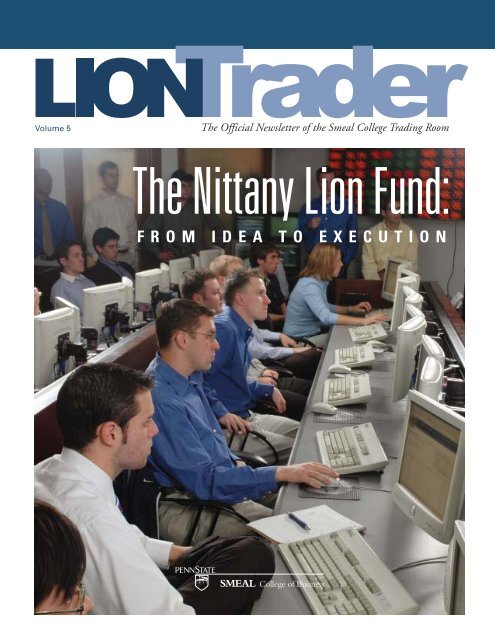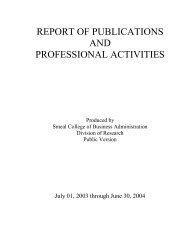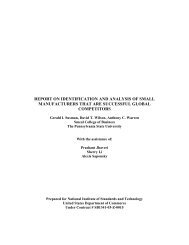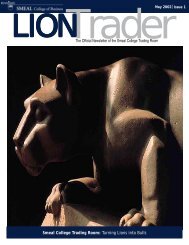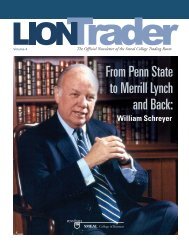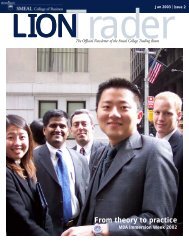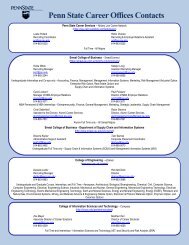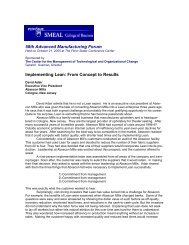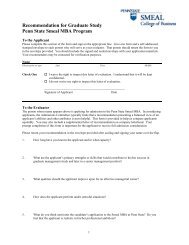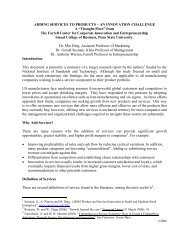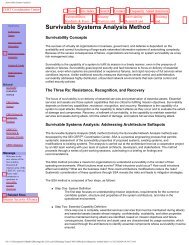The Nittany Lion Fund - Smeal College of Business
The Nittany Lion Fund - Smeal College of Business
The Nittany Lion Fund - Smeal College of Business
You also want an ePaper? Increase the reach of your titles
YUMPU automatically turns print PDFs into web optimized ePapers that Google loves.
Volume 5<br />
<strong>The</strong> Official Newsletter <strong>of</strong> the <strong>Smeal</strong> <strong>College</strong> Trading Room<br />
<strong>The</strong> <strong>Nittany</strong> <strong>Lion</strong> <strong>Fund</strong>:<br />
FROM IDEA TO EXECUTION
Inside this Issue...<br />
F E A T U R E D A R T I C L E S<br />
<strong>The</strong> <strong>Nittany</strong> <strong>Lion</strong> <strong>Fund</strong>: From Idea to Execution ....................................... 4<br />
This <strong>Fund</strong> was created to provide students in the <strong>Smeal</strong> <strong>College</strong> <strong>of</strong> <strong>Business</strong> at Penn State with an active<br />
learning environment where they can put to practice the principles they have learned in the classroom.<br />
Conversation with Alumni: Tackling the Job Market Head First ............. 9<br />
<strong>Lion</strong>Trader recently spoke with two new alumni and a recruiter about the state <strong>of</strong> the job market.<br />
Student Research Article: A Look into Hedge <strong>Fund</strong> Regulation ............ 14<br />
Hedge fund regulation has recently become a highly debated topic in the United States, with strongly contested positions<br />
on both sides <strong>of</strong> the argument.<br />
TABLE OF CONTENTS<br />
Message from the Trading Room .......................................................... 3<br />
<strong>The</strong> <strong>Nittany</strong> <strong>Lion</strong> <strong>Fund</strong>: From Idea to Execution ................................... 4<br />
Bloomberg Global Product Certification Comes to Penn State .......... 7<br />
<strong>Smeal</strong> Update ........................................................................................... 8<br />
Conversation with Alumni: Tackling the Job Market Head First ........ 9<br />
Stock Selection Strategies with Richard Gould .................................. 10<br />
Snap Judgement: <strong>The</strong> Rise, Fall, and Return <strong>of</strong> Snapple.................. 11<br />
CEO Perspective: Stephen Courter, NEON Communications ........... 12<br />
Student Research Article: A Look into Hedge <strong>Fund</strong> Regulation ....... 14<br />
Book Reviews ......................................................................................... 15<br />
Penn State Team Succeeds at the Rotman<br />
International Trading Competition ....................................................... 16<br />
<strong>Lion</strong>Trader Staff ..................................................................................... 16<br />
On the cover: Student managers <strong>of</strong> the <strong>Nittany</strong> <strong>Lion</strong> <strong>Fund</strong> research new investment<br />
opportunities.<br />
2
MESSAGE FROM THE TRADING ROOM<br />
Introducing David Haushalter, New Academic Director<br />
This semester the <strong>Smeal</strong> <strong>College</strong> <strong>of</strong><br />
<strong>Business</strong> introduced a new member,<br />
David Haushalter, to its faculty.<br />
David received his undergraduate degree<br />
and MBA from West Virginia University.<br />
He worked at Fred Kolber and Associates<br />
and then later at Susquehanna International<br />
Group as an Equity Options<br />
Trader.<br />
After this stint in the business world,<br />
David took his knowledge and experience<br />
to Purdue University where he earned his<br />
Ph.D. He then took a position at<br />
University <strong>of</strong> Oregon as a finance<br />
pr<strong>of</strong>essor. David then moved back to<br />
Pennsylvania to work again with<br />
Susquehanna in the area <strong>of</strong> Education<br />
and Corporate Research. It was from<br />
there that Penn State sought David<br />
Haushalter to take on the position as a<br />
pr<strong>of</strong>essor and the Academic Director <strong>of</strong><br />
the Trading Room. Regarding the move,<br />
David said, “It is the perfect place right<br />
now for my family and me.”<br />
As the Academic Director <strong>of</strong> the Trading<br />
Room, David has big plans for the<br />
Trading Room internship program and<br />
all the students in <strong>Smeal</strong>. David also<br />
displays a genuine excitement not only<br />
to work in the Trading Room, but also<br />
to work with the 40 or so interns in the<br />
Trading Room program. When asked<br />
what makes the Penn State Trading Room<br />
unique, he responds, “<strong>The</strong> Trading Room<br />
really brings everything together. It <strong>of</strong>fers<br />
a centralized location for a wide array <strong>of</strong><br />
data sources. Rather than having all <strong>of</strong><br />
the systems that we have scattered<br />
throughout the University, we have them<br />
all there, side by side.”<br />
One <strong>of</strong> the most useful features <strong>of</strong> the<br />
Trading Room, according to David, is the<br />
room’s ability to simulate a marketplace<br />
using the FTS s<strong>of</strong>tware. David is also<br />
excited to develop new projects that<br />
exploit the room’s facilities. Using systems<br />
such as Bloomberg and Reuters, students<br />
can gain a better understanding <strong>of</strong> a<br />
specific company, discuss specific events<br />
or sequences <strong>of</strong> events pertaining to that<br />
company, make predictions as to what<br />
will happen in the marketplace and then<br />
compare their expectations with what<br />
eventually plays out in the marketplace.<br />
David has some plans to improve the<br />
Trading Room as it moves to the new<br />
<strong>Smeal</strong> <strong>Business</strong> Building. He plans to<br />
improve the layout so that it will take on<br />
the resemblance <strong>of</strong> a classroom more so<br />
than the current lab-like layout. He also<br />
plans to make the workspaces more<br />
conducive to collaboration and<br />
teamwork.<br />
David’s big goal for his first year as<br />
Academic Director <strong>of</strong> the <strong>Smeal</strong> Trading<br />
Room is to make sure that all business<br />
students are exposed to the advantages <strong>of</strong><br />
the Trading Room, have opportunities to<br />
work in the room, and acquire the<br />
knowledge to utilize the available systems.<br />
In anticipation <strong>of</strong> the upcoming years,<br />
David says, “I think that this is an exciting<br />
opportunity. <strong>The</strong> challenge is to<br />
maximize the potential <strong>of</strong> these resources.<br />
David Haushalter, Clinical Assistant<br />
Pr<strong>of</strong>essor <strong>of</strong> Finance, and Academic<br />
Director <strong>of</strong> Trading Room<br />
<strong>The</strong> room allows us to show students how<br />
the skills that they are learning in class<br />
can be applied to real world settings and<br />
compare decisions that they are making<br />
to people’s decisions in the marketplace.<br />
It really takes learning to a whole new<br />
level.”<br />
— Brian Dunlap, <strong>Lion</strong>Trader Staff<br />
3
<strong>The</strong> <strong>Nittany</strong> <strong>Lion</strong> <strong>Fund</strong>:<br />
From Idea to Execution<br />
History <strong>of</strong> the Penn State Investment Association<br />
<strong>The</strong> Penn State Investment Association was founded in fall 1999<br />
with the intention <strong>of</strong> providing students with a strong foundation<br />
in the functioning <strong>of</strong> capital markets. In designing the<br />
organization, the primary founders, Ali Chaudhry and Nathan<br />
Kline, sought to involve students in the research, analysis, and<br />
maintenance <strong>of</strong> a securities portfolio using a hands-on approach<br />
that would effectively bridge the gap between classroom concepts<br />
and real-world situations.<br />
Moving forward to spring 2000 semester, the club existed in a<br />
trial phase and assumed the role <strong>of</strong> a provisional organization.<br />
At this point, the club maintained its exclusivity and carried<br />
out general meetings accordingly. At first, decisions were<br />
primarily made regarding geographic regions, and research chairs<br />
reflected these areas as well. However, concentration shifted to<br />
sectors more closely reflecting the S&P shortly thereafter.<br />
Obtaining the authorization <strong>of</strong> the University for <strong>of</strong>ficial<br />
organization status was <strong>of</strong> paramount importance during this<br />
period and was successfully granted. <strong>The</strong> founders attribute the<br />
ease <strong>of</strong> acceptance to PSIA’s interactive and realistic qualities, which<br />
differentiate it from virtually any other organization.<br />
In order to have an efficient organization with a structure that<br />
defines leadership and team roles, PSIA started a mock portfolio<br />
after becoming an <strong>of</strong>ficial club. Over the past several years, the<br />
club has been growing and operating successfully with this fund<br />
management type structure. During the 2003-2004 academic<br />
years, the idea <strong>of</strong> getting real money started to materialize and<br />
become a more realistic goal. Under the presidency <strong>of</strong> Sachin<br />
Aggarwal, the board <strong>of</strong> directors brainstormed constantly about<br />
the proposal <strong>of</strong> managing real money. <strong>The</strong> leaders <strong>of</strong> PSIA knew<br />
this would be a fantastic opportunity for students to take real<br />
risks and force the members <strong>of</strong> the organization to be more diligent<br />
with their research.<br />
It was at the <strong>Smeal</strong> Board <strong>of</strong> Visitors meeting in New York City<br />
in April 2004 that the idea was <strong>of</strong>ficially accepted. <strong>The</strong> passionate<br />
leaders <strong>of</strong> PSIA finally made the idea <strong>of</strong> launching an actual fund<br />
a reality.<br />
Student managers conduct research as part <strong>of</strong> the <strong>Nittany</strong> <strong>Lion</strong> <strong>Fund</strong> class.<br />
4
<strong>The</strong> Inception <strong>of</strong> the <strong>Nittany</strong> <strong>Lion</strong> <strong>Fund</strong><br />
During fall 2004, the ball started rolling on<br />
organizing the structure for the <strong>Nittany</strong> <strong>Lion</strong><br />
<strong>Fund</strong>. During this time, the legal structure was<br />
being formed as a Limited Liability<br />
Corporation, under Penn State, by using a<br />
trust account at Mellon Bank. <strong>The</strong><br />
complicated placement documents spelled out<br />
the limits for compliance, such as market<br />
capitalization requirements, fund objectives,<br />
and risk management. As part <strong>of</strong> its creation,<br />
the management structure was also<br />
established.<br />
<strong>The</strong> <strong>Nittany</strong> <strong>Lion</strong> <strong>Fund</strong> managers are elected<br />
from the leadership inside the Penn State<br />
Investment Association. In PSIA, the board<br />
Continued on page 6.<br />
Student managers applaud the opening trades<br />
<strong>of</strong> the <strong>Nittany</strong> <strong>Lion</strong> <strong>Fund</strong>.<br />
Portfolio Analysis Group Commentary<br />
for the week <strong>of</strong> March 7, 2005 to<br />
March 11, 2005<br />
Here is a look at our portfolio holdings and performance as <strong>of</strong> March 15, 2005,<br />
when we finalized the magazine for print, with commentary from the Director<br />
<strong>of</strong> the Portfolio Analysis Group, Yoichi Takemura.<br />
<strong>The</strong> overall market shrugged with the S&P 500 Index down by 1.80% for<br />
the week <strong>of</strong> March 7-11. <strong>The</strong> long-term benchmark 10-year interest rate<br />
spiked up to the highest level since last July after the Beige Book reported<br />
increasing fears <strong>of</strong> higher inflation. Furthermore, the U.S. trade deficit<br />
widened by 4.5% in January, the second highest gap on record. Oil prices<br />
remained high around the $54-55 per barrel range, which pushed the market<br />
even lower. <strong>The</strong> market is likely to continue reacting significantly to changes<br />
in inflation expectations, retail sales, the PPI, and new home building<br />
numbers coming out over the next few weeks. Also, on March 22 at the<br />
regular FOMC meeting, the market is expecting that the Fed will raise the<br />
FFT rate by 25bp to 2.75%.<br />
<strong>The</strong> <strong>Nittany</strong> <strong>Lion</strong> <strong>Fund</strong> portfolio finished higher than the benchmark index,<br />
but with a weekly loss <strong>of</strong> 1.19% on our equity investment. Among the best<br />
performers <strong>of</strong> the week were General Dynamics and L3 Communications,<br />
both <strong>of</strong> which reacted positively to new contracts. On the other hand,<br />
Genentech Inc. was down by 4.05% for the week, and is now trading close<br />
to its 52 week low <strong>of</strong> $41. We still believe that Genentech is fundamentally<br />
strong, but recent negative momentum has pushed down the stock price.<br />
PORTFOLIO HOLDINGS & PERFORMANCE: MARCH 15, 2005<br />
Company Name Symbol Close Shares Value Paid $ Gain % Gain Sector Yield P/E<br />
Apple AAPL 40.96 2,400 $98,304.00 36.575 $10,494.00 12.0% Information Technology N/A 65.0x<br />
Abercrombie & Fitch ANF 56.55 2,100 $118,755.00 49.960 $13,809.21 13.2% Consumer Discretionary 0.9% 24.7x<br />
Aptar Group ATR 51.46 500 $25,730.00 47.798 $1,801.00 7.5% Materials 1.2% 20.7x<br />
Avaya AV 12.72 1,800 $22,896.00 14.410 ($3,072.00) (11.8%) Telecommunications N/A 20.7x<br />
Bank <strong>of</strong> America BAC 45.54 2,500 $113,850.00 45.630 ($255.00) (0.2%) Financials 3.9% 12.4x<br />
Consol Energy CNX 45.12 800 $36,096.00 44.850 $208.00 0.6% Energy 1.2% 35.9x<br />
CostCo COST 45.32 1,800 $81,576.00 44.830 $874.00 1.1% Consumer Staples 0.9% 22.3x<br />
Cytec Industries CYT 52.12 500 $26,060.00 52.200 ($48.00) (0.2%) Materials 0.8% 18.3x<br />
Danaher DHR 54.25 1,900 $103,075.00 55.250 ($1,930.00) (1.8%) Industrials 0.1% 23.7x<br />
Genentech DNA 54.25 2,000 $108,500.00 46.660 $15,150.00 16.2% Healthcare N/A 75.3x<br />
Eaton Vance EV 24.60 4,600 $113,160.00 24.390 $936.46 0.8% Financials 1.3% 23.5x<br />
FedEx FDX 98.63 1,100 $108,493.00 94.170 $4,876.11 4.7% Industrials 0.3% 23.6x<br />
General Dynamics GD 109.00 1,000 $109,000.00 102.340 $6,630.10 6.5% Industrials 1.5% 18.4x<br />
Johnson & Johnson JNJ 67.26 1,500 $100,890.00 64.500 $4,110.00 4.3% Healthcare 1.7% 23.9x<br />
Kinder Morgan Partners KMP 46.16 800 $36,928.00 45.770 $282.00 0.8% Energy 6.4% 21.0x<br />
L-3 Communications LLL 75.23 350 $26,330.50 70.290 $1,699.00 6.9% Telecommunications 0.7% 22.7x<br />
Micros<strong>of</strong>t MSFT 24.91 3,300 $82,203.00 26.150 ($4,122.00) (4.8%) Information Technology 1.3% 27.3x<br />
Northwestern Natural Gas NWN 36.15 500 $18,075.00 33.190 $1,450.05 8.7% Utilities 3.6% 19.5x<br />
Panera Bread PNRA 54.66 2,200 $120,252.00 50.650 $8,792.00 7.9% Consumer Discretionary N/A 43.5x<br />
Texas Instruments TXN 25.72 3,800 $97,736.00 25.880 ($637,62) (0.7%) Information Technology 0.4% 25.0x<br />
UST Corp. UST 54.18 1,600 $86,688.00 49.500 $7,458.00 9.4% Consumer Staples 4.1% 16.8x<br />
Western Gas WGR 35.86 1,300 $46,618.00 30.020 $7,562.00 19.4% Energy 0.6% 23.5x<br />
Totals $1,681,215.50 $76,067.30 4.7% 1.2% 29.6x<br />
5
<strong>The</strong> <strong>Nittany</strong> <strong>Lion</strong> <strong>Fund</strong> continued<br />
Dr. J. Randall Woolridge, <strong>The</strong> Goldman<br />
Sachs and Co. and Frank P. <strong>Smeal</strong> Endowed<br />
University Fellow and Pr<strong>of</strong>essor <strong>of</strong> Finance;<br />
President, <strong>Nittany</strong> <strong>Lion</strong> <strong>Fund</strong>, LLC.<br />
<strong>of</strong> directors consists <strong>of</strong> a President, Vice<br />
President, Secretary, and Treasurer which<br />
all help oversee the process and<br />
procedures in the organization. <strong>The</strong><br />
functional board consists <strong>of</strong> directors <strong>of</strong><br />
Equity Research, Economic Analysis,<br />
Portfolio Analysis/Trading, and<br />
Compliance. Historically, PSIA was an<br />
undergraduate club, but now several<br />
<strong>Smeal</strong> MBA’s hold crucial positions in the<br />
Economic Analysis and Trading groups.<br />
A <strong>Fund</strong> Manager class was set up for<br />
spring 2005 in order to formalize the<br />
meeting times and responsibility for these<br />
fund managers. <strong>The</strong> <strong>Fund</strong> Manager class<br />
operates under the direction <strong>of</strong> Dr. Randy<br />
Woolridge, CEO <strong>of</strong> the <strong>Nittany</strong> <strong>Lion</strong><br />
<strong>Fund</strong>. Each Monday, Wednesday, and<br />
Friday at 10:00 a.m. the class meets to<br />
discuss portfolio activities. Typically, there<br />
are economic and market related<br />
discussions, presentations <strong>of</strong> new equity<br />
ideas, and meetings with pr<strong>of</strong>essionals in<br />
the industry who advise on the fund<br />
strategy.<br />
<strong>The</strong> corporation was approved in late<br />
2004. We completed fund raising in<br />
January 2005. <strong>The</strong> <strong>Nittany</strong> <strong>Lion</strong> <strong>Fund</strong><br />
raised $2.275 million for initial inception,<br />
and the <strong>Fund</strong> will be reopened periodically<br />
for additional investments.<br />
— Sean Spillmann & Jonathan Wyss,<br />
<strong>Lion</strong>Trader Co-editors-in-chief<br />
Who’s Who in the <strong>Nittany</strong> <strong>Lion</strong> <strong>Fund</strong><br />
Co-Managers<br />
Dr. Judy Olian<br />
Gary Schultz<br />
William Krakaw<br />
Board <strong>of</strong> Directors<br />
Edward Hintz, Chairman<br />
Dr. J. Randall Woolridge,<br />
Chief Executive Officer<br />
Dr. Judy Olian, ex-<strong>of</strong>ficio<br />
J. David Rogers<br />
Arthur Miltenburger<br />
Alumni Oversight Committee<br />
Blake Gall<br />
Charles S. Lipson<br />
Edward Sebastian<br />
Donald Wallace<br />
<strong>Fund</strong> Manager Board<br />
<strong>of</strong> Directors<br />
• Sean Spillman (<strong>Nittany</strong> <strong>Lion</strong> <strong>Fund</strong><br />
Director & former President, PSIA)<br />
• Jonathan Wyss<br />
(<strong>Nittany</strong> <strong>Lion</strong> <strong>Fund</strong> Director &<br />
former Vice President, PSIA)<br />
• Ryan Miller<br />
(Current President, PSIA)<br />
• Frank Howard<br />
(Current Vice President, PSIA)<br />
• Andrew Repine (Secretary)<br />
• Patrick McShane (Treasurer)<br />
• William H<strong>of</strong>fman<br />
Director, Compliance)<br />
• Eugene Weissberger<br />
(Director, Equity Research)<br />
• Yoichi Takemura<br />
(Director, Portfolio Analysis Group)<br />
• Andrew Woolridge<br />
(Director, Economic Analysis Group)<br />
• Ben Leax (Undergraduate Director,<br />
Economic Analysis Group)<br />
<strong>Fund</strong> Managers & Sector Lead<br />
Analysts<br />
• Emily Alcorn (Lead Analyst,<br />
Consumer Discretionary)<br />
• John Beberus (Lead Analyst,<br />
Information Technology)<br />
• Michael Boarts (Lead Analyst,<br />
Telecommunications)<br />
• Celena Cross<br />
(Lead Analyst, Financials)<br />
• Phillip Hawkins<br />
(Lead Analyst, Materials)<br />
• Chan Hei Io (<strong>Fund</strong> Manager)<br />
• Daniel Kokini<br />
(Lead Analyst, Utilities)<br />
• John Nelson<br />
(Lead Analyst, Healthcare)<br />
• Chirayu Patel (Lead Analyst, Energy)<br />
• Allison Pavlick (Lead Analyst,<br />
Consumer Staples)<br />
• Michael Schuman (<strong>Fund</strong> Manager)<br />
• Matt Seiler (Lead Analyst, Industrials)<br />
www. smeal.psu.edu/fund/<br />
6
Bloomberg Global Product Certification Program<br />
Comes to Penn State<br />
<strong>The</strong> <strong>Smeal</strong> <strong>College</strong> <strong>of</strong> <strong>Business</strong> has<br />
always sought to supplement<br />
traditional in-class learning with<br />
additional opportunities for students to<br />
enhance their education. In accordance<br />
with this objective, the finance department,<br />
along with the <strong>Smeal</strong> Trading Room,<br />
has taken considerable steps to make<br />
Bloomberg Pr<strong>of</strong>essional certification<br />
courses an ongoing and more importantly,<br />
on-campus, program at Penn State.<br />
This effort by the university has been<br />
extremely popular. Within hours <strong>of</strong> its<br />
announcement, the first class, set for<br />
almost two weeks later, completely filled<br />
its maximum occupancy level <strong>of</strong> 100<br />
students. Ravi Menon, a senior finance<br />
undergraduate student, luckily enough to<br />
register in time, spoke <strong>of</strong> the course with<br />
particular enthusiasm, describing the<br />
opportunity as “a chance to gain handson<br />
skills and applicable knowledge prior<br />
to entering the real world.”<br />
On January 27, 2005, Pablo Castro, a<br />
Bloomberg representative, kicked-<strong>of</strong>f the<br />
much anticipated certification program —<br />
a basic introduction to the s<strong>of</strong>tware with<br />
focuses on both ‘level-one’ fixed income<br />
and equity data applications—to a packed<br />
classroom in the Willard Building.<br />
<strong>The</strong> value <strong>of</strong> a certification in Bloomberg<br />
Pr<strong>of</strong>essional stems from the far-reaching<br />
influence the s<strong>of</strong>tware has on global<br />
financial markets. As the world’s leading<br />
in-depth financial information provider,<br />
Bloomberg <strong>of</strong>fers its users extremely<br />
pertinent and comprehensive data at a<br />
real-time pace. Those well trained in its<br />
functionality are able to swiftly navigate<br />
through the immense financial database,<br />
utilize the many analytical tools, and gain<br />
significant advantages in the market place.<br />
Furthermore, the pervasive nature <strong>of</strong> the<br />
Bloomberg service in major corporations<br />
makes those familiar with the product<br />
more attractive to employers.<br />
Since 2001, Bloomberg University has<br />
<strong>of</strong>fered the Bloomberg Certification<br />
Program to recognize various levels <strong>of</strong><br />
pr<strong>of</strong>iciency in Bloomberg Pr<strong>of</strong>essional<br />
S<strong>of</strong>tware. Bloomberg’s well-structured<br />
certification program provides coverage<br />
for introductory to advanced functions in<br />
Equity, Fixed Income, and Foreign<br />
Exchange. Each <strong>of</strong> these three specified<br />
certification tracks are <strong>of</strong>fered at three<br />
levels in which a certificate <strong>of</strong> pr<strong>of</strong>iciency<br />
is issued.<br />
Bloomberg users interested in starting a<br />
full certification track begin by enrolling<br />
in five introductory courses that include<br />
basic functionality common to all three<br />
tracks. This includes Bloomberg<br />
introductory commands, real-time<br />
monitoring, charting, news and economic<br />
release information, and data exportation<br />
to Micros<strong>of</strong>t Excel. Upon completion <strong>of</strong><br />
the introductory courses, the Bloomberg<br />
user continues the structured training by<br />
selecting one or more tracks to complete.<br />
In each track, all Level I and II courses<br />
are mandatory for certification <strong>of</strong> those<br />
or subsequent levels (all courses are<br />
mandatory for Level III <strong>of</strong> Foreign<br />
Exchange as well). <strong>The</strong> number <strong>of</strong> courses<br />
in Level I and II range from 3 courses per<br />
level to 6 courses per level. However, after<br />
successfully completing Levels I and II <strong>of</strong><br />
the Equity and Fixed Income tracks the<br />
participant is given the option to select<br />
four Level III electives which include<br />
highly specialized topics that will help<br />
optimize the participant’s performance on<br />
work-related tasks. Examples <strong>of</strong> Level III<br />
courses include “Equity Portfolio<br />
Management Strategy,” “Merger and<br />
Acquisition Analysis,” “Credit Derivatives,”<br />
and “Foreign Exchange Option<br />
Analytics.”<br />
After attending each course seminar,<br />
participants are required to pass a tenquestion<br />
multiple-choice online exam on<br />
course-specific functionality. Through the<br />
Continued on page 8.<br />
7
Bloomberg Global Product Certification Program Comes to Penn State continued<br />
full attendance <strong>of</strong> the required courses and<br />
the satisfactory completion <strong>of</strong> the online<br />
exams, the participant is issued a certificate<br />
verifying that user’s pr<strong>of</strong>iciency and<br />
competency in the Bloomberg Pr<strong>of</strong>essional<br />
s<strong>of</strong>tware.<br />
While many participants complete the<br />
course training via live seminars at<br />
Bloomberg <strong>of</strong>fices around the world, it is<br />
also possible to fulfill course training through<br />
arrangement <strong>of</strong> exclusive sessions provided<br />
by a Bloomberg representative at the client’s<br />
location as well as the option to complete<br />
course modules via teleconference/<br />
interactive tutorials through the client’s<br />
Bloomberg terminal.<br />
classes, have been split up into two one-hour<br />
classes, each in a different area <strong>of</strong> focus:<br />
Bloomberg-Equity and Bloomberg-Fixed<br />
Income. Although students cannot receive<br />
their Bloomberg Certification by attending<br />
these classes, the knowledge and skills gained<br />
are very similar. Moreover, the program both<br />
enables and encourages a larger volume <strong>of</strong><br />
students to take advantage <strong>of</strong> the two<br />
Bloomberg terminals available in the trading<br />
room.<br />
—Eric Chambers & Morgan Samet,<br />
<strong>Lion</strong>Trader Staff<br />
In order to accommodate the surplus <strong>of</strong><br />
students interested in Bloomberg, the <strong>Smeal</strong><br />
Trading room has developed a shorter, more<br />
simplified, lecture series to be presented by<br />
trading room interns on a frequent basis.<br />
<strong>The</strong>se classes, which mimic the material<br />
discussed in the Bloomberg certification<br />
Source: Bloomberg<br />
For more information, visit http://www.bloomberg.com, or CERT on Bloomberg Pr<strong>of</strong>essional.<br />
<strong>Smeal</strong> Update<br />
Construction crews and equipment<br />
are some <strong>of</strong> the common sights<br />
that Penn Staters <strong>of</strong>ten see on their<br />
daily travels through campus. Penn State<br />
is an ever-expanding school with an everexpanding<br />
student body. <strong>The</strong> <strong>Smeal</strong><br />
<strong>College</strong> <strong>of</strong> <strong>Business</strong> is a part <strong>of</strong> this<br />
activity, as they construct a brand-new,<br />
210,000 square-foot building, which will,<br />
at the beginning <strong>of</strong> the fall semester 2005,<br />
be the largest academic facility at Penn<br />
State. This new building will finally bring<br />
the entire <strong>Smeal</strong> <strong>College</strong> <strong>of</strong> <strong>Business</strong><br />
together under one ro<strong>of</strong>. <strong>The</strong> halls <strong>of</strong> the<br />
building will be filled with twenty-two<br />
classrooms, an auditorium, and <strong>of</strong>fices for<br />
business clubs, advisors, and faculty.<br />
Presentations can be given in the<br />
auditorium or videotaped and critiqued<br />
in breakout rooms located within the<br />
building. As the Dean Judy Olian says,<br />
“this new building will be the ‘home away<br />
from home’ for all <strong>of</strong> <strong>Smeal</strong> students.”<br />
<strong>The</strong> new building will be equipped with<br />
lounges and common areas as well as a<br />
café and outdoor plaza, making it easy<br />
for students to relax and refuel. <strong>The</strong><br />
completion date for the new building is<br />
set for the summer <strong>of</strong> 2005. It will be<br />
completely occupied by the start <strong>of</strong> the<br />
fall 2005 semester.<br />
Other big news for <strong>Smeal</strong> comes from US<br />
News and World Report which has ranked<br />
the college’s full-time MBA program as<br />
37 th overall, 18 th among public universities,<br />
and 8 th in Supply Chain Management.<br />
Students at all levels from Penn State’s<br />
<strong>Smeal</strong> <strong>College</strong> <strong>of</strong> <strong>Business</strong> have successfully<br />
participated in a variety <strong>of</strong> competitions<br />
during the spring semester. <strong>Smeal</strong> MBA<br />
students came in first in both the Annual<br />
Big Ten MBA Case Competition and in<br />
the International Logistics Case<br />
Competition. A team <strong>of</strong> four undergraduate<br />
students finished third in the<br />
Rotman International Trading<br />
Competition. (See back cover.) Another<br />
team <strong>of</strong> four undergraduate students also<br />
took a third place finish in the Marshall<br />
International Case Competition.<br />
—Brian Dunlap, <strong>Lion</strong>Trader Staff<br />
8
Conversation with Alumni:<br />
Tackling the Job Market Head First<br />
<strong>Lion</strong>Trader recently spoke with two<br />
new alumni and a recruiter about<br />
the state <strong>of</strong> the job market.<br />
When the economy began its downward<br />
fall in 2002, companies put hiring on<br />
hold and were even letting go <strong>of</strong><br />
thousands <strong>of</strong> employees. <strong>The</strong> graduating<br />
class was going through a tough time,<br />
scrambling for jobs and even having to<br />
take alternative routes such as graduate<br />
school or a temporary job unrelated to<br />
their field <strong>of</strong> study. Fortunately, the<br />
economy has picked up considerably in<br />
recent years with an upward trend in<br />
merger and acquisition deal volume as<br />
well as hiring.<br />
Sachin Aggarwal, an investment banker<br />
at Merrill Lynch, recalled William<br />
Schreyer’s monumental visit to Penn State<br />
in 2002 with Merrill Lynch Head <strong>of</strong><br />
Global Markets and Investment Banking<br />
Group (GMI) recruiter, Joe Casey. This<br />
turning point and declaration <strong>of</strong> Penn<br />
State as a target school, made future<br />
graduates even more marketable to other<br />
bulge bracket investment banks like<br />
Goldman Sachs and JP Morgan, who<br />
began to recruit on campus thereafter.<br />
Out <strong>of</strong> the 404 people in Aggarwal’s<br />
incoming class at Merrill Lynch, 20 were<br />
Penn Staters.<br />
Citigroup Sales and Trading Analyst and<br />
alumnus David Hua opened up his own<br />
job possibilities by applying online to<br />
firms not listed for on-campus recruiting.<br />
As a member <strong>of</strong> the Goldman Sachs<br />
recruiting team and an analyst in the<br />
Investment Banking division, Alicia<br />
Cheng can attest to the level <strong>of</strong> hiring she’s<br />
seen this year and the increased<br />
competition among the applicant pool.<br />
“Students are doing more than ever to<br />
competitively position themselves for<br />
analyst programs at investment banks. For<br />
example, the typical resume <strong>of</strong> a college<br />
senior now lists two or three summer<br />
internships, whereas in previous years,<br />
internship experience was more <strong>of</strong> a rarity,”<br />
said Cheng.<br />
At Merrill Lynch, Aggarwal has noticed<br />
a growing need for more investment<br />
bankers, but flatter hiring in sales and<br />
trading due to a lack <strong>of</strong> need. Though<br />
the job market is strong now, Aggarwal<br />
is quick to remind graduates that hiring<br />
is forever dependent on the economy.<br />
“I don’t anticipate a tech bubble again<br />
with people being promoted and hired<br />
like crazy and given obscene bonuses.<br />
Something like that is hard to believe. You<br />
need to ask yourself ‘Is the economy<br />
saturated at this point?’ Who knows what<br />
the future will hold?” said Aggarwal.<br />
Aggarwal noted that the biggest change<br />
in the job market has been the accounting<br />
and financial services industry scandals<br />
and the negative media surrounding it.<br />
“It’s not like anything has changed greatly<br />
and people have all <strong>of</strong> a sudden become<br />
evil. It’s just the way things have<br />
progressed. <strong>The</strong> catalyst has been the<br />
question,” said Aggarwal.<br />
With this in mind, it is vital to know what<br />
recruiters are looking for in candidates<br />
today. Cheng stated that in addition to an<br />
eagerness to learn and creativeness,<br />
Goldman Sachs looks for team players<br />
because the firm’s environment is so<br />
collaborative. In addition, because <strong>of</strong> their<br />
worldwide scope, Goldman looks for<br />
“leaders who can work effectively with<br />
leaders,” said Cheng. Hua added that some<br />
constants employers look for are people<br />
who are able to think on their feet, have<br />
the drive to succeed, and can maintain a<br />
positive attitude. One thing Aggarwal has<br />
noticed is that the culture and fit <strong>of</strong> a<br />
candidate to the firm are just as important<br />
to recruiters.<br />
<strong>The</strong> job search is never an easy one and at<br />
times, can be disappointing, stressful, and<br />
frustrating. Cheng advised the importance<br />
<strong>of</strong> talking to people in the industry to gain<br />
perspective on the job and its fit, as well as<br />
to gain a deeper understanding and insight<br />
in preparing for interviews. She also<br />
suggested that students get involved in the<br />
Penn State Investment Association,<br />
Trading Room Internship, and <strong>Lion</strong>Trader<br />
to demonstrate their genuine interest to<br />
recruiters and gain a competitive edge.<br />
Aggarwal cited the importance <strong>of</strong> hard<br />
work and self-motivation, especially at a<br />
school as big as Penn State where it is easy<br />
to get lost. “Know what you want and go<br />
after it; don’t back down. Chaos breeds<br />
opportunity and if you’re able to harness<br />
that opportunity and use the infinite<br />
resources at Penn State such as the alumni<br />
network, you’ll be able to make yourself<br />
more marketable,” said Aggarwal. But with<br />
all that in mind, the job search still comes<br />
down to one thing—being proactive and<br />
hungry for the job you are seeking.<br />
“It is up to the student to find what job<br />
they want. Not many firms out there<br />
knock on the doors <strong>of</strong> their potential<br />
employees. It is up to the student to<br />
pursue the firm,” said Hua.<br />
—Annie Chang, <strong>Lion</strong>Trader Staff<br />
9
Stock Selection Strategies with Richard Gould<br />
Richard Gould, founder <strong>of</strong> the Rockland Small Cap <strong>Fund</strong>,<br />
paid a visit to Penn State to discuss his success as a fund<br />
manager and provide insight for students about how to<br />
run an investment fund.<br />
Richard Gould entered the Penn State MBA program from the<br />
world <strong>of</strong> corporate finance. He quickly learned that in order to<br />
get into a competitive position in finance, you need to take<br />
advantage <strong>of</strong> your contacts, so he did. Using his mentor at Penn<br />
State, Pr<strong>of</strong>essor Randall Woolridge, Gould met with various<br />
alumni on Wall Street. Upon graduation, Mr. Gould thought<br />
his most educational experience would be at PNC Provident<br />
Capital, choosing them over IBM, who <strong>of</strong>fered him nearly<br />
double the salary.<br />
Within Provident Capital, Gould concentrated his efforts in<br />
the Equity Research department, taking all the small cap<br />
industries that senior employees detested—trucking, technology,<br />
and insurance. (He added Micros<strong>of</strong>t to the firm’s portfolio after<br />
recognizing the company’s potential.)<br />
Gould left PNC in 1994 after seven years to join Greenville<br />
Capital, but quickly realized that he did not believe in Greenville’s<br />
investment strategy and wanted to branch <strong>of</strong>f on his own.<br />
<strong>The</strong>refore, in 1996 with $140 million in capital, Gould started<br />
the Rockland Small Cap fund, which would focus on investing<br />
in firms with less than a $1.6 billion market capitalization.<br />
Gould discussed his strategy on picking the best companies out<br />
<strong>of</strong> this volatile class <strong>of</strong> equities. <strong>The</strong> beauty to his technique is<br />
that it can and should be applied to every investment strategy,<br />
regardless <strong>of</strong> market cap standards. <strong>The</strong> four main ways that<br />
Gould suggests to analyze a corporation are:<br />
1) gauging a company’s executive management<br />
2) public announcements<br />
3) tradeshows<br />
4) timing<br />
According to Gould, small cap companies love to talk about<br />
their company, but the problem is that they are always looking<br />
for ways to talk them up. <strong>The</strong> difficulty comes in measuring<br />
their responses to questions because it involves qualitative<br />
judgment in the reactions <strong>of</strong> people. Little things make a big<br />
difference, from the length <strong>of</strong> a pause to body language. More<br />
than just reading body language, however, you want to know<br />
that a company has set clear, distinct goals for five, ten, and<br />
fifteen years down the road.<br />
Tradeshows go hand-in-hand with gauging a company’s executive<br />
management because they give you the opportunity to have<br />
discussions with a CEO in a less casual environment. Gould’s<br />
advice is to use tradeshows to discover things about a firm’s supply<br />
chain that you may not have already known. Ask the CEO<br />
questions like, “Who do you do the most business with on the<br />
east coast?” Take that information and go find out how that<br />
business is actually doing on the east coast. Use every angle you<br />
can to make sure you are investing your money in the right<br />
company. This is something personal investors never go to great<br />
lengths to do. Perhaps this is why some fund managers beat the<br />
S&P, while the majority do not.<br />
Public announcements are another great way to add content to<br />
your analysis <strong>of</strong> a company. This is where a lot <strong>of</strong> experience in<br />
equity research paid <strong>of</strong>f for Mr. Gould. When a company makes a<br />
public announcement, it is imperative to check the information<br />
against your estimates, especially when a company meets or beats<br />
the Street. According to Gould, “If a company beats earnings<br />
expectations, and you see a large increase in accounts receivable,<br />
this could be an irregular increase to accounts receivable and<br />
subsequently net income. Moreover, days-sales-outstanding<br />
explodes, and the company’s management may have dishonestly<br />
beefed-up earnings by pushing managers to sell whatever they can<br />
by the end <strong>of</strong> the quarter.” Gould’s advice is to “Sell if you are<br />
already an owner or do not buy the stock if a balance sheet<br />
irregularity such as this appears. Dishonest management is an added<br />
risk not worth taking. In the end it will only do an investor harm.”<br />
Another angle to public announcements again requires discussion<br />
with management. One <strong>of</strong> Gould’s favorite questions to ask a<br />
CEO is, “When you report earnings, if you miss Wall Street<br />
estimates, what would your post-boardroom response be?” He<br />
said that sometimes a CEO will simply laugh at you and other<br />
times they will give you hypothetical situations. If a CEO gives<br />
you a hypothetical situation, Gould said, “You have to take it<br />
seriously and decide whether it is a realistic situation or not.”<br />
Lastly, but very important, is timing. Timing is a factor in both<br />
buying and selling equities. One <strong>of</strong> Mr. Gould’s favorite times<br />
to buy a stock is a couple weeks before a conference, which is<br />
abnormal for the rest <strong>of</strong> the industry. Most analysts will go to a<br />
conference, do their research, and two or three weeks after the<br />
conference, the firm will buy shares <strong>of</strong> a viable company. Gould’s<br />
philosophy takes advantage <strong>of</strong> investor psychology during that<br />
period. A few weeks before the conference, after he has completed<br />
his research on the company or companies holding the conference,<br />
Continued on page 13.<br />
10
Snap Judgement: <strong>The</strong> Rise and Fall <strong>of</strong> Snapple<br />
<strong>The</strong> following account outlines the<br />
remarks <strong>of</strong> Michael Weinstein in a<br />
lecture in the <strong>Smeal</strong> <strong>College</strong> <strong>of</strong> <strong>Business</strong><br />
Trading Room in fall 2004.<br />
It began in 1972 with three men. Two<br />
window washers and a health food store<br />
owner decided to break out <strong>of</strong> the mold<br />
and market drinks that were Made from<br />
the best stuff on earth. <strong>The</strong> company began<br />
by marketing fruit juices, seltzers, and<br />
sodas in 1986, but did not find its claim<br />
to fame until a year later when it began to<br />
brew a Ready-to-Drink tea.<br />
Soon after, in 1992, Unadulterated Food<br />
Products, Inc. was purchased and quickly<br />
renamed Snapple. Gaining momentum in<br />
the public’s eye through an advertising<br />
campaign with personalities like discjockey<br />
Howard Stern, talk show host Rush<br />
Limbaugh, and Wendy Kaufman and her<br />
“Greetings from Snapple” ads, Snapple<br />
began to expand rapidly in the Ready-to-<br />
Drink tea market.<br />
With the success that Snapple exhibited<br />
in the early 1990’s, it drew a great deal <strong>of</strong><br />
attention from the larger beverage<br />
companies and those trying to establish<br />
themselves within the Ready-to-Drink tea<br />
market. On December 6, 1994, Quaker<br />
Oats purchased Snapple for $1.7 billion.<br />
<strong>The</strong> purchase price was seen as a grossly<br />
overpaid investment for Quaker Oats<br />
(purchasing Snapple at 28.6x earnings and<br />
3.3x revenue), but Quaker was confident<br />
with its purchase after having incredible<br />
success with Gatorade. Quaker was going<br />
to follow the blueprint <strong>of</strong> Gatorade and<br />
try to prove the critics wrong.<br />
After Quaker Oats purchased Snapple, it<br />
began to implement marketing and sales<br />
strategies previously successful with<br />
Gatorade. <strong>Business</strong> quickly turned sour.<br />
Quaker ran into several problems<br />
including excessive inventories, low<br />
demand for container sizes greater than 16<br />
ounces, and troubled retail sales. Quaker<br />
was running Snapple into a weakened<br />
state, while Lipton and Nestea were<br />
growing fat on Snapple’s market share. As<br />
a result, Snapple suffered a $75 million<br />
loss in 1995. Snapple’s sales growth had<br />
slowed from double digits to -5%.<br />
<strong>Business</strong>Week published an article calling<br />
Quaker’s acquisition <strong>of</strong> Snapple “one <strong>of</strong><br />
the Top Ten worst mergers <strong>of</strong> the 1990’s.”<br />
Snapple was in a tailspin and falling<br />
quickly to depths from which most<br />
companies would not be able to recover.<br />
But, two years after the acquisition, Triarc,<br />
a small beverage company, acquired<br />
Snapple from Quaker for approximately<br />
$300 million. Over the two years that<br />
Quaker Oats held onto Snapple, they lost<br />
an average <strong>of</strong> $2 million a day.<br />
Triarc decided to try and save a falling star.<br />
<strong>The</strong> challenge for them would be to<br />
appoint a new leader with the ambition<br />
to turn the brand around. With previous<br />
experience and success in the beverage<br />
industry, Michael Weinstein was the man<br />
for the job. After first being approached<br />
with the task, Michael accepted with belief<br />
that Triarc did not have the resources to<br />
obtain the giant Snapple. Fortunately for<br />
Snapple, Triarc was able to complete the<br />
purchase and install Michael Weinstein as<br />
CEO <strong>of</strong> their beverage group.<br />
Immediately, being a perceptive marketer,<br />
Weinstein began to change everything that<br />
Quaker did. Michael was not there to<br />
simply try to take what Quaker had given<br />
him and let the Snapple name continue<br />
to disintegrate. Instead, Weinstein came<br />
in with the purpose to break all <strong>of</strong> the rules<br />
that Quaker established. Reviving the<br />
name Snapple would be a tough task that<br />
few would be willing to take on. Risking<br />
his reputation, Weinstein went head to<br />
head with the beverage giant that had sent<br />
Quaker reeling to its heels and began<br />
making changes immediately.<br />
Marketing is Weinstein’s claim to fame<br />
within the beverage industry, and he would<br />
not let Triarc down. Bringing back<br />
personalities like Howard Stern, Rush<br />
Limbaugh, and Wendy Kaufman, the<br />
brand quickly regained its quirky image<br />
that loyal drinkers loved and new ones<br />
were attracted to. During this process,<br />
Weinstein introduced new products to the<br />
Snapple line. With WhipperSnapple,<br />
Elements, and Wendy’s Tropical<br />
Inspiration in homage to Wendy’s return,<br />
the brand began to increase sales and regain<br />
attention from all <strong>of</strong> the companies in the<br />
Ready-to-Drink tea business. Eventually,<br />
Cadbury Schweppes would purchase the<br />
company for $1.45 billion, and included<br />
a position for Weinstein promising not to<br />
tamper with his distribution or marketing<br />
anytime soon. Weinstein successfully<br />
brought back the giant that was all but<br />
given the ten-count.<br />
How was Michael Weinstein able to do<br />
the unthinkable and bring back a product<br />
once seen as a lost cause? In his words, he<br />
would tell you there are a few things you<br />
need: confidence, passion, and rule<br />
breaking. It was those rules that led him<br />
to be the topic <strong>of</strong> case studies everywhere.<br />
When his Trading Room Lecture Series<br />
presentation came to an end, he left<br />
everyone with three rules to remember for<br />
the corporate world:<br />
1. Avoid buzzwords.<br />
2. Avoid Acronyms.<br />
3. Always break the rules.<br />
It was the final piece <strong>of</strong> advice that truly<br />
stood out the most. After all, it was that<br />
attitude that placed his name in the<br />
Beverage Hall <strong>of</strong> Fame.<br />
—William H<strong>of</strong>fman, <strong>Lion</strong>Trader Staff<br />
11
CEO PERSPECTIVE<br />
Stephen Courter on the Corporate<br />
Restructuring <strong>of</strong> NEON Communications<br />
<strong>The</strong> <strong>Smeal</strong> <strong>College</strong> Trading Room<br />
recently welcomed Stephen<br />
Courter, Chairman and CEO <strong>of</strong><br />
NEON Communications, as part <strong>of</strong> its<br />
continuing Lecture Series. Courter, a Penn<br />
State <strong>Smeal</strong> alumnus and former ROTC<br />
cadet, obtained his B.S. in Finance in<br />
1977. Beginning his career at KPMG LLP,<br />
Courter later moved to IBM, and would<br />
finally join NEON Communications in<br />
December 2000. Last November, Courter<br />
discussed with <strong>Smeal</strong> students his career<br />
experiences and the recent debt<br />
restructuring and merger activity <strong>of</strong><br />
NEON Communications.<br />
NEON Communications, an advanced<br />
optical networking service provider,<br />
primarily operates in the Northeast and<br />
mid-Atlantic regions, particularly in tier<br />
two and tier three cities. <strong>The</strong> company was<br />
formed in 1998 during the Telecom boom,<br />
and after landing its first two major<br />
customers, NEON went public through<br />
an IPO valued at $46 million. NEON’s<br />
revenue figures were initially impressive,<br />
amounting to $24 million annually,<br />
however the company’s balance sheet was<br />
laden with over $200 million in debt and<br />
yearly capital expenditures were nearly $20<br />
million. Still, Courter saw opportunity.<br />
NEON was a company with a strong<br />
network, solid revenues, and little<br />
competition, factors that led Courter to<br />
join NEON as CEO in 2000.<br />
Upon entering the company, Courter<br />
prepared NEON for a major debt<br />
restructuring. He conserved cash by<br />
freezing headcount, reevaluating contracts,<br />
and reducing capital expenditures.<br />
He also went on roadshows in attempts to<br />
raise additional capital. Courter also met<br />
with bond investors and arranged for the<br />
sale <strong>of</strong> NEON’s debt at a discount <strong>of</strong><br />
twenty cents on the dollar. However,<br />
NEON was unable to raise the additional<br />
capital required, and debtholders began to<br />
pressure NEON’s Board <strong>of</strong> Directors for<br />
the negotiation <strong>of</strong> a Debt-for-Equity Swap.<br />
In 2002, Stephen Courter obtained Board<br />
approval for a Debt-for-Equity swap, and<br />
met with bondholders to negotiate the<br />
terms. Arranging for a pre-packaged<br />
bankruptcy, Courter gained Court<br />
approval in June 2002 to exchange $12<br />
million in debtor-in-possession financing<br />
for NEON’s debt. While in bankruptcy,<br />
NEON was also able to cut other costs by<br />
eliminating excess warehousing, leases, and<br />
unnecessary contracts. <strong>The</strong>se restructuring<br />
efforts eliminated the majority <strong>of</strong> NEON’s<br />
excessive costs, allowing it to emerge from<br />
bankruptcy in 2003 with over $40 million<br />
in annual revenue and positive cash flow.<br />
When asked to contrast NEON’s healthy<br />
recovery from bankruptcy with the<br />
continuing struggles currently plaguing<br />
the airline industry, Courter identified the<br />
uniqueness <strong>of</strong> NEON itself as being the<br />
differentiating factor. “We had a unique<br />
footprint in the Northeast,” Courter<br />
stated. “In order for a bankruptcy to work,<br />
it needs to have a unique survivable<br />
business underpinning it.”<br />
12
From this point on, Courter focused his<br />
interest on acquiring other companies;<br />
however, as a privately traded company,<br />
NEON was in no position to make<br />
competitive <strong>of</strong>fers. <strong>The</strong> only feasible<br />
solution was for NEON to solve its<br />
acquisition currency issues by merging<br />
with a publicly traded company–Globix,<br />
an applications web-hosting company.<br />
Although Globix is a highly leveraged<br />
company, the merger makes sense<br />
strategically. Courter says, “We could<br />
solve Globix’s debt problems with our<br />
cash flow, and Globix could solve our<br />
currency problems by making us public<br />
with this merger. In the capital markets<br />
this merger [makes] a lot <strong>of</strong> sense.” <strong>The</strong><br />
merger also makes sense to investors. <strong>The</strong><br />
vertical integration <strong>of</strong> the two companies<br />
should create synergies, reducing major<br />
costs and exploiting complementary<br />
products that would stimulate revenue<br />
growth. <strong>The</strong> combined company is<br />
projected to produce about $152 million<br />
in revenues and approximately $34<br />
million in EBITDA.<br />
<strong>The</strong> merger was <strong>of</strong>ficially announced in<br />
July 2004, filed with the SEC in October,<br />
and was expected to close in early January<br />
2005. NEON is currently identifying postmerger<br />
objectives and developing strategies<br />
to optimize the operating synergies <strong>of</strong> the<br />
combined company. Other post-merger<br />
strategies include purchasing other<br />
networks and web-hosting companies,<br />
strengthening the balance sheet, and<br />
providing liquidity to investors.<br />
Courter concluded his presentation with<br />
some valuable advice for <strong>Smeal</strong> students:<br />
First, “Seek opportunities early, stay<br />
flexible, and relocate.” Courter attributes<br />
many <strong>of</strong> the opportunities he received to<br />
the fact that he was willing to work in six<br />
different countries during his career.<br />
Second, “Manage people as early as you<br />
can. This is the one skill set that will never<br />
erode,” stated Courter. “My skill set is not<br />
fiber optics, and it’s not finance; it’s my<br />
ability to manage people and manage<br />
processes.” Third, “Have a passion for<br />
change; it creates opportunity.” Fourth,<br />
“Know where the money comes from and<br />
know where it goes.” He elaborated,<br />
“Take as much accounting as you can<br />
stand. Without accounting knowledge<br />
you’re flying blind in the business world.<br />
Also, learn a second language, and<br />
specialize in a unique one.” Courter is<br />
fluent in German, and admits that it has<br />
helped him get where he is today. “Above<br />
all,” said Courter, “Do what’s right.<br />
Develop your business compass early, and<br />
follow your gut. Chances are your instinct<br />
is right.”<br />
—Jamie Gresh, <strong>Lion</strong>Trader Staff<br />
Stock Selection Strategies with Richard Gould continued from page 10<br />
Gould may buy one <strong>of</strong> the stocks at, say, $16. During the<br />
conference the market bids the company up to $18 or $19, and<br />
when analysts finally recognize the value in the firm, they have<br />
bid the stock up to $22. At this point Gould sells a percentage <strong>of</strong><br />
his holdings in the company after having easily taken advantage<br />
<strong>of</strong> the price increase.<br />
When buying, Gould also uses technical analysis to take advantage<br />
<strong>of</strong> trend divergence and “scratches and claws for every quarter <strong>of</strong> a<br />
penny.” If the action observed is unusual, he will get right on the<br />
phone with the CEO to see what the issue is. Gould’s decision to<br />
sell a stock is largely technically based. When he observes sustained<br />
selling in bulk, he gets out. Almost never though, does he unwind<br />
100% <strong>of</strong> his holdings in a single equity at once. He says the thing<br />
to remember is “News is always best at the peak.” When there are<br />
large blocks <strong>of</strong> shares coming <strong>of</strong>f the table, 25-100 thousand shares<br />
at a time, it is usually another institutional investor with a larger<br />
stake in the company. <strong>The</strong> greater portion <strong>of</strong> a company that you<br />
own, the more frequently you will receive information and the<br />
more reliable it will be.” Gould takes advantage <strong>of</strong> this inevitable<br />
discrepancy between the little guy and the big investor by tracking<br />
a stock and checking it several times a day.<br />
When Gould is confident that institutional investors are dumping<br />
their shares, why not dump the entire stake in the company?<br />
Institutional investors have an edge on the market that is only<br />
surpassed by CEOs, dumping it all would make sense. However,<br />
to sell all your shares at once usually requires selling them at a<br />
discount to the market. <strong>The</strong>refore, by dumping all your shares at<br />
once you <strong>of</strong>ten sacrifice any gains for convenience and speed.<br />
At the end <strong>of</strong> his presentation Mr. Gould left his audience with<br />
some advice, “Learn as much as you can, in any possible way and<br />
prove that you are learning by becoming a Certified Financial<br />
Analyst (CFA).”<br />
—Daniel Kokini, <strong>Lion</strong>Trader Staff<br />
13
STUDENT RESEARCH ARTICLE<br />
A Look Into Hedge <strong>Fund</strong> Regulations<br />
Hedge fund regulation has recently<br />
become a highly debated topic in<br />
the United States, with strongly<br />
contested positions on both sides <strong>of</strong> the<br />
argument. Scandals in many U.S.<br />
businesses and industries have almost<br />
become commonplace, and many people<br />
believe that more regulation will prevent<br />
these abuses <strong>of</strong> power. On the other hand,<br />
many feel that new regulations would<br />
diminish the benefits <strong>of</strong> investing in hedge<br />
funds. Additionally, the SEC already has<br />
enough work on its plate, and it does not<br />
have sufficient resources to be policing<br />
another industry.<br />
It is interesting to follow the progress <strong>of</strong><br />
SEC regulation on institutional investing<br />
during the past few years, especially in light<br />
<strong>of</strong> the increasing scrutiny placed on<br />
accounting practices, mutual funds,<br />
investment banks, and, now, hedge funds.<br />
One could argue that the proposed hedge<br />
fund regulation is the end result <strong>of</strong> a chain<br />
<strong>of</strong> scandals beginning with the highly<br />
publicized accounting scandals <strong>of</strong> Enron,<br />
World Com, and various other comp-anies.<br />
Hedge funds are just the most recent<br />
industry to debate new regulation and<br />
attract the watchful eye <strong>of</strong> New York<br />
Attorney General Elliot Spitzer.<br />
In the past, hedge funds were generally<br />
ignored by regulation entities such as the<br />
SEC. Loose wording <strong>of</strong> the Investment<br />
Advisor’s Act <strong>of</strong> 1940 has allowed hedge<br />
fund managers to avoid registering as an<br />
investment advisor (a requirement <strong>of</strong> most<br />
mutual fund managers). Under the<br />
definition <strong>of</strong> this act, managers do not have<br />
to register if they have fewer than 15 clients.<br />
Many hedge fund managers have<br />
voluntarily registered in an attempt to<br />
exercise clean practices, but the majority<br />
<strong>of</strong> hedge fund managers are still<br />
unregistered.<br />
SEC regulators are now proposing a change<br />
in this convention, making it mandatory<br />
for hedge funds with total assets equaling<br />
$25 million or greater to register under the<br />
Investment Advisor’s Act <strong>of</strong> 1940.<br />
Furthermore, it is believed that the SEC<br />
will propose that hedge funds be required<br />
to follow through with the ensuing list 1 :<br />
• Develop best practices standards.<br />
• Provide brochures describing their<br />
investment strategies as well as other<br />
e nhanced disclosures.<br />
• Follow a standardized portfolio<br />
valuation process.<br />
• Develop a culture <strong>of</strong> compliance.<br />
• Provide more information about their<br />
layered fee structure as was indicated by<br />
recommendations made by SEC staff in<br />
September <strong>of</strong> 2003.<br />
Under these new regulations, the SEC<br />
would ultimately mandate that hedge<br />
funds more openly communicate their<br />
firm’s practices and fee structure, which<br />
could have a variety <strong>of</strong> effects on the<br />
industry.<br />
1<br />
Christine Williamson, “Don’t underestimate the SEC in its pursuit <strong>of</strong> fraud cases, warns Paul Roye,”<br />
Pension & Investments Vol.32, Iss. 14, 12 July 2004, pg 1.<br />
2<br />
Ibid.<br />
3<br />
William H. Donaldson to U.S. Senate, 15 July 2004, “Testimony Concerning Investor Protection and<br />
the Regulation <strong>of</strong> Hedge <strong>Fund</strong>s Advisers”, U.S. Senate, Washington D.C.<br />
Naturally, many hedge fund managers<br />
oppose these restrictions because they<br />
would lose many significant advantages<br />
that they have in their investment<br />
strategies, while increasing costs for<br />
registration and maintenance fees.<br />
Jonathon Bean, managing director <strong>of</strong> the<br />
hedge fund management organization<br />
Mellon HBV Alternative Strategies in New<br />
York, makes the comparison that “the U.K.<br />
has regulated hedge funds for years and it’s<br />
clear that it has severely damaged the<br />
industry there. Many individuals don’t<br />
believe that it even deters fraudulent<br />
practices, which is the whole purpose <strong>of</strong><br />
the regulation.” 2<br />
SEC Chairmen William H. Donaldson<br />
contends that there would be many benefits<br />
<strong>of</strong> registration requirements. With control<br />
<strong>of</strong> close to $1 trillion dollars in assets, the<br />
hedge fund industry has a significant effect<br />
on the economy and the financial markets.<br />
According to one <strong>Business</strong> Week article, a<br />
single hedge fund manager, at times, can<br />
induce a 5% shift in the daily volume <strong>of</strong><br />
trading on the New York Stock Exchange 3 .<br />
With this magnitude <strong>of</strong> an influence, it<br />
seems regulation and forced registration is<br />
needed to increase the SEC’s ability to<br />
detect and prevent fraud. This is especially<br />
true given the fast pace with which hedge<br />
funds are growing and the increasing<br />
number <strong>of</strong> smaller investors with exposure<br />
to them.<br />
No regulations have been finalized, but it<br />
is widely anticipated that the proposed<br />
legislation will be passed. It will be<br />
interesting to measure the effects <strong>of</strong> the<br />
impending decision, but until then,<br />
interested parties on both sides <strong>of</strong> the issue<br />
are relegated to watching from the sidelines.<br />
Andrew Repine, <strong>Lion</strong>Trader Staff<br />
14
Book Reviews<br />
Book Review: Ugly Americans by Ben Mezrich<br />
Ugly Americans tells the story <strong>of</strong> John Malcolm, an Ivy League<br />
graduate and ex-football star who builds a successful sales and<br />
trading career in Japan. <strong>The</strong> story begins with the typical<br />
employment search for the above-average student, interviewing<br />
extensively for that big-time Wall Street opportunity. After<br />
minimal success, Malcolm finally stumbles upon an irresistible<br />
<strong>of</strong>fer from an American expatriate who had already realized<br />
much financial success in Japan. He would eventually accept<br />
the <strong>of</strong>fer, launching what would be a remarkable career trading<br />
on the Nikkei.<br />
This success would not come easy for Malcolm, however, as he<br />
experiences much conflict both on the desk, grappling with<br />
the volatile Asian financial markets, as well as outside <strong>of</strong> work,<br />
with gangs, night-club dwellers, and women. Despite such<br />
obstacles, Malcolm’s dynamic personality would shine, from<br />
executing $25 million worth <strong>of</strong> transactions his first day on<br />
the job to realizing a climactic arbitrage opportunity towards<br />
the end <strong>of</strong> the novel.<br />
Mezrich introduces the climate <strong>of</strong> the 1990’s Asian financial<br />
markets and the nature <strong>of</strong> Japanese culture in a breathtaking<br />
novel. For those who are interested in sales and trading and<br />
international finance, Ugly Americans is a must-read.<br />
—Ryan Miller, <strong>Lion</strong>Trader Staff<br />
Book Review: Hidden Risk: Understanding<br />
Off-Balance Sheet Accounting by J. Edward Ketz<br />
Corporate frauds related to improper accounting procedures<br />
have tainted the reputations <strong>of</strong> many firms in recent years such<br />
as Cendant, Duke Energy, AOL Time Warner, Waste<br />
Management, Boston Chicken, Sunbeam, Qwest, and Tyco.<br />
Creative accounting tactics used by these firms included<br />
inaccurate depreciation/amortization charges, premature<br />
revenue recognition, and misleading business combination<br />
accounting.<br />
In Hidden Financial Risk, Ketz focuses on failures that attributed<br />
to the understatement <strong>of</strong> corporate liabilities and debt<br />
obligations. Such examples in recent history involved Adelphia,<br />
Global Crossing, WorldCom, and Enron. He begins with an<br />
overview <strong>of</strong> how financial leverage affects stock prices, bond<br />
ratings, and financial risk. Ketz specifically clarifies how each<br />
<strong>of</strong> the perpetrating firms hid debt via the use <strong>of</strong> the equity<br />
method, lease accounting schemes, pension accounting<br />
procedures, and the development <strong>of</strong> corporate subsidiaries<br />
known as SPE’s. Furthermore, he explores the failures <strong>of</strong><br />
managers, directors, financial statement auditors, regulatory<br />
bodies, and investors in detecting the financial risks that were<br />
prevalent in these scandals. Ketz concludes by advocating for<br />
high ethical business standards, pr<strong>of</strong>essional skepticism, and<br />
support for the “public interest.” His closing recommendations<br />
on how to restore credibility and comprehension to financial<br />
statements prove to be beneficial to investment pr<strong>of</strong>essionals<br />
and individual investors alike.<br />
Financial reporting and accounting ethics expert J. Edward<br />
Ketz is an Associate Pr<strong>of</strong>essor <strong>of</strong> Accounting at Penn State. He<br />
has 30 years <strong>of</strong> experience studying the intricacies <strong>of</strong> fixed<br />
income and derivatives accounting.<br />
—Eric Chambers, <strong>Lion</strong>Trader Staff<br />
15
PSU Team Succeeds at the Rotman<br />
International Trading Competition<br />
On February 18 and 19, Alex Keller,<br />
DeJian Fang, Eugene Weissberger, and<br />
William H<strong>of</strong>fman represented Penn State<br />
in the second annual Rotman International<br />
Trading Competition at the<br />
University <strong>of</strong> Toronto. This team was<br />
created after a series <strong>of</strong> competitions held<br />
at <strong>The</strong> <strong>Smeal</strong> <strong>College</strong> Trading Room<br />
where each team member held the top<br />
cumulative cash positions after simulated<br />
trading competitions using FTS.<br />
Soon after the second competition, the<br />
last competition began. Penn State’s<br />
strategy was to retain its current position.<br />
<strong>The</strong> last part <strong>of</strong> the competition got <strong>of</strong>f<br />
to a slow start due to problems with the<br />
team’s model, which erroneously<br />
calculated the intrinsic values <strong>of</strong> the<br />
stocks and bonds being used. With some<br />
quick revisions, it didn’t take long for the<br />
team to get back on track, finishing third<br />
in the last competition.<br />
In the end, Penn State earned a third place<br />
finish, but first out <strong>of</strong> all the United States<br />
teams. Although they lost to a team from<br />
England and another from Canada, they<br />
beat out teams from MIT, Carnegie<br />
Mellon University, University <strong>of</strong> Texas,<br />
and big ten rivals Ohio State and<br />
Michigan.<br />
—William H<strong>of</strong>fman, <strong>Lion</strong>Trader Staff<br />
<strong>The</strong> first day <strong>of</strong> competition consisted <strong>of</strong><br />
an Open Outcry Simulation. <strong>The</strong> Penn<br />
State team, competing against 24 other<br />
schools, began on the right foot and<br />
finished in third place in the first <strong>of</strong> three<br />
competitions. On the second day, the<br />
Penn State team competed in another<br />
Open Outcry simulation based on an<br />
index that was composed <strong>of</strong> six economic<br />
indicators. <strong>The</strong> Penn State team finished<br />
second.<br />
<strong>The</strong> Penn State Team after the competition: (l-r) Eugene Weissberger, DeJian Fang,<br />
Alex Keller, and William H<strong>of</strong>fman<br />
CO-EDITORS-IN-CHIEF<br />
Sean Spillman<br />
ses936@psu.edu<br />
Jonathan Wyss<br />
jaw932@psu.edu<br />
MANAGING EDITOR<br />
Ryan Miller<br />
rkm153@psu.edu<br />
COPY EDITOR<br />
Jamie Gresh<br />
jlg390@psu.edu<br />
GRAPHICS EDITOR<br />
John Hammarstedt<br />
jeh315@psu.edu<br />
STAFF<br />
Adam Gucwa<br />
Eric Chambers<br />
Morgan Samet<br />
Brian Dunlap<br />
William H<strong>of</strong>fman<br />
Andrew Repine<br />
Annie Chang<br />
Daniel Kokini<br />
Staff<br />
This publication is available in alternative media on request.<br />
Penn State is committed to affirmative action, equal opportunity, and the diversity <strong>of</strong> its workforce.<br />
U.Ed. BUS 05-93 MPC81060clh<br />
TECHNICAL ADVISER<br />
Suzanne Wayne<br />
16


